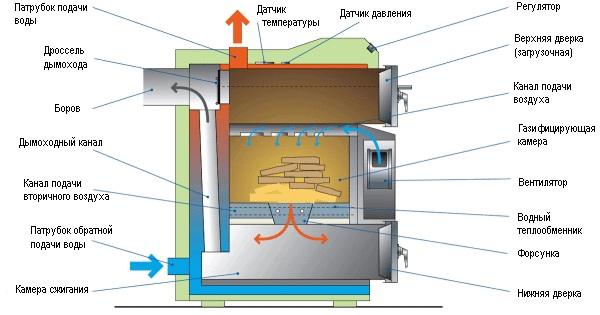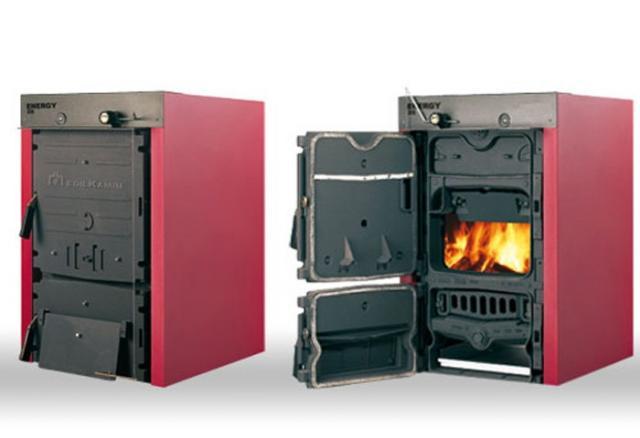Wood-fired boiler for heating
In the age of unprecedented advances in science, it is already difficult to imagine that someone, somewhere else, heats a room with firewood. However, they are still not forgotten, and even today they are not at all uncommon. True, today these are no longer old Russian stoves, and not even their elegant tiled counterparts.
Most modern ones combine two components - a traditional, centuries-old source of energy - simple firewood and a steam heating system that came into use relatively recently - just some 100-150 years ago.
To a city dweller, of course, this may seem like a relic of a long past. But in many villages and dachas, boilers are still used to heat a wood-fired house. And given the growing demand for everything natural, solid fuel boilers can be increasingly found in cottage settlements. And it's not about the high efficiency and high heat transfer of this heating method. It’s just that in the minds of many there is a strong association of the open flame of a wood-burning stove with a feeling of calm, comfort and security.
And in those places of our boundless Motherland, where the main gas pipeline has not yet reached, wood-burning boilers, in fact, are the only way to organize steam heating.
The design of a solid fuel boiler
The design of a wood-fired boiler is nothing new. On the contrary, it was in his image and likeness that the gas water heater, familiar to many of us from childhood, and its “big brother” - a gas boiler, were once created. Only instead of a gas burner in wood-burning boilers, a flame of burning solid fuel is used, which can be used not only for firewood, but also for any of their substitutes - peat, coal, and even combustible household waste.
As in a gas column, a radiator is placed above the combustion chamber, usually made of a heat-resistant pipe twisted in a spiral. The pipe is connected to a closed steam heating circuit and, at the request of the owners, to a hot water supply system.

Wood-burning heating boiler and its operation scheme
The effect of this simple device is obvious. Water enters the boiler, passing through the heat exchanger, heats up and is fed to the outlet - through a pipe to the batteries. Water supply and pressure in the system is regulated by taps.
Unlike gas, coal and firewood do not burn without a trace. Even in the most efficient furnaces, they still leave ash, which accumulates in a special container - an ash pan. It is located under the stove and is separated by a heat-resistant grate. From time to time, the ash from the ash pan must be poured out. Otherwise, it will accumulate so much that there will be nowhere to put firewood.
A little about firewood
Let's talk now about fuel - about firewood. When planning the installation of a wood-burning boiler, it is necessary to take care of both compliance with a huge number of fire regulations and guidelines, and the supply of firewood for a certain period. You are not going to follow them into the forest every day! You should also think about a place to store them, protected from direct moisture.
Usually, firewood is harvested for the winter and stored in a utility room or in the yard under a canopy. The required amount is determined empirically. It depends on many factors:
- climate conditions
- the thickness of the walls and the material from which your home is built
- its heated area
- your personal feelings of microclimate comfort

Wood-fired boilers
In places remote from the gas pipeline, solid fuel boilers are used not only in domestic conditions, but also on an industrial scale. Industrial boilers for burning solid fuels differ from household ones in size and greater automation of the process.
So, the amount of fuel, water temperature and pressure level in the pipe are monitored by special sensors connected to the built-in processor. Often the same processor controls the automated fuel supply. With the help of indicators, it notifies you about the degree of filling of the ash container. Automation of the process, having reduced energy losses, allowed to maximize the efficiency of the boiler, as well as to minimize the consumption of combustible material and the amount of waste.
It makes no sense to talk about the advantages and disadvantages that wood heating has. Their use is resorted to as a forced measure in the absence of gas. There is no longer a choice. In the case when wood heating is a whim of the designer, again, comparisons are superfluous. Must means must.
In general, wood heating is more troublesome and costly than gas heating. But nothing warms the soul like the crackling of dry firewood in the stove and the sight of an open flame over the firewood.
